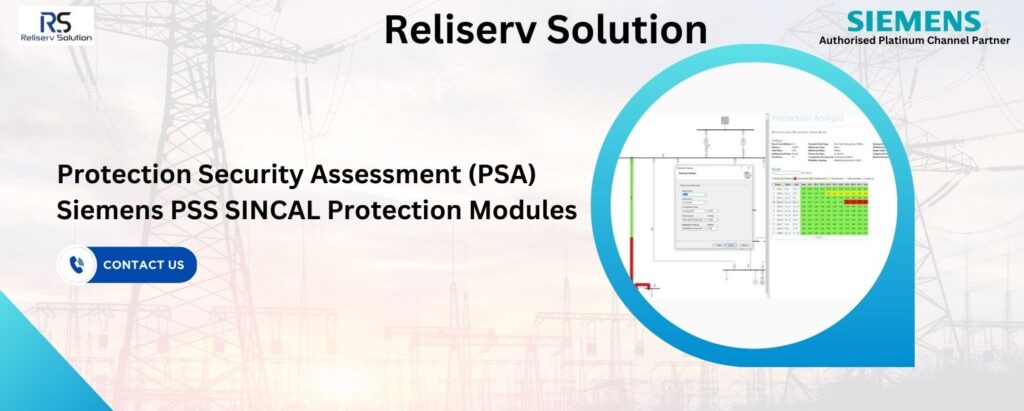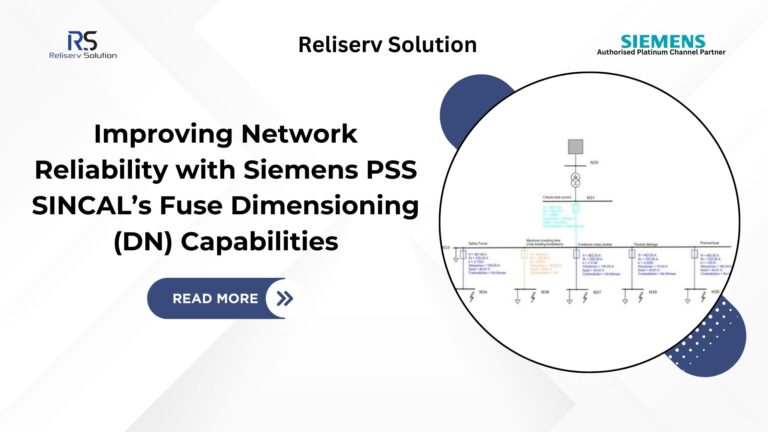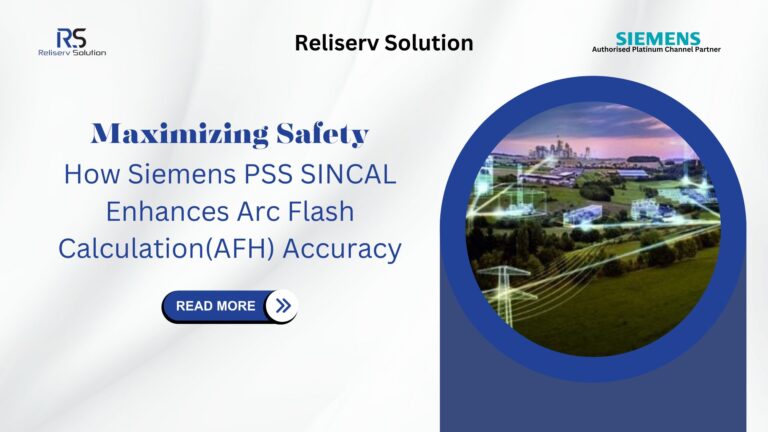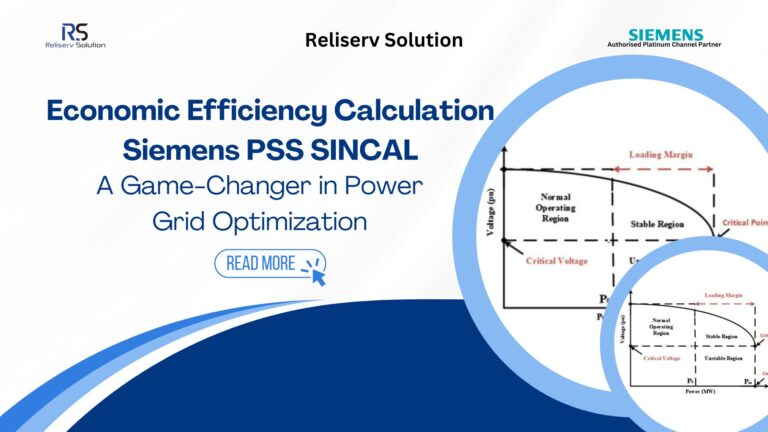In the ever-evolving landscape of electrical power systems, ensuring the security and reliability of protection mechanisms is paramount. A Protection Security Assessment (PSA) is a critical process that evaluates the effectiveness of protection schemes and devices, identifying vulnerabilities and recommending improvements. Siemens PSS SINCAL Protection Modules offer a comprehensive suite of tools for conducting thorough PSAs, enabling power system operators to improve the robustness of their protection strategies including Siemens Simulation Softwares PSS SINCAL Supplier. This blog delves into the steps and best practices for conducting an effective PSA using Siemens PSS SINCAL Protection Modules.
Importance of Protection Security Assessment (PSA) using Siemens PSS SINCAL Protection Modules.
Protection Security Assessment is a systematic evaluation of the protective devices and schemes in a power system. It aims to ensure that these devices operate correctly under various fault conditions and coordinate effectively to isolate faults, thereby maintaining system stability and preventing widespread outages including Siemens Simulation Softwares PSS SINCAL Supplier. PSA involves analyzing relay settings, verifying coordination, and assessing the overall protection strategy to identify potential weaknesses and areas for improvement even for Siemens Simulation Softwares PSS SINCAL Supplier.
Protection Security Assessment (PSA)
The verification of the ordered operation (selectivity, speed, dependability, and security) of the network protection based just on input data/grading diagrams is frequently insufficient in meshed networks and networks with a large penetration of distributed generation including Siemens Simulation Softwares PSS SINCAL Supplier. It is therefore essential to verify the protection settings of the complete network protection for all potential fault locations in addition to keeping an eye out for particular fault events in the protection simulation. Finding the weak places in the network protection system is essential, even though it must be done quickly.
The number of switching operations in the network rises with the growing number of decentralized energy resources (DER) with variable power flow. This necessitates a brief examination of the network’s overall security from the perspective of network operation (e.g. before each switching operation).
Key Steps in Conducting an Effective PSA with Siemens PSS SINCAL Protection Modules
Step 1: Data Collection and System Modeling
The first step in conducting a PSA is gathering comprehensive data about the power system. This includes:
- Network topology and configuration.
- Detailed information about protective devices (relays, circuit breakers, fuses).
- Relay settings and coordination parameters.
- Historical fault data and system performance records.
Siemens PSS SINCAL Protection Modules facilitate the creation of accurate and detailed system models using this data. The software’s intuitive interface allows engineers to input and visualize the network configuration, ensuring that all relevant information is captured.
Step 2: Simulation of Fault Scenarios
Once the system model is established, the next step is to simulate various fault scenarios. This involves introducing faults at different locations in the network and analyzing the response of the protective devices. Siemens PSS SINCAL Protection Modules provide robust simulation capabilities, allowing engineers to:
- Simulate single-phase, phase-to-phase, and three-phase faults.
- Evaluate the performance of protective relays under different fault conditions.
- Analyze the timing and coordination of relay operations.
These simulations help identify potential issues such as overreach, underreach, or miscoordination of protective devices.
Step 3: Relay Coordination Analysis
Relay coordination is crucial to ensure that protective devices operate selectively and isolate only the faulted section of the network. In this step, engineers use Siemens PSS SINCAL Protection Modules to analyze the time-current characteristics (TCC) of relays and adjust their settings for optimal coordination. Key activities include:
- Reviewing TCC curves to identify overlaps or gaps in protection zones.
- Adjusting relay settings to achieve desired coordination margins.
- Ensuring that primary and backup protection schemes are effectively coordinated.
Effective relay coordination minimizes the risk of unnecessary tripping and enhances the overall reliability of the protection system.
Step 4: Sensitivity Analysis
Sensitivity analysis involves evaluating the robustness of the protection schemes under varying system conditions. This includes changes in load levels, network configurations, and fault impedance. Siemens PSS SINCAL Protection Modules enable engineers to conduct sensitivity analysis by:
- Simulating different operating conditions and fault scenarios.
- Assessing the impact of these changes on relay performance and coordination.
- Identifying settings that provide robust protection across a range of conditions.
Sensitivity analysis helps ensure that the protection schemes remain effective even as the system evolves.
Step 5: Verification and Validation
Verification and validation are critical to ensure that the protection schemes function as intended in real-world conditions. This step involves:
- Field testing of protective devices to verify their performance.
- Comparing simulation results with actual field data to validate the accuracy of the system model.
- Fine-tuning relay settings based on test results and real-world performance.
Siemens PSS SINCAL Protection Modules support integration with field data, enabling engineers to validate their simulations and make data-driven adjustments to the protection schemes even for Siemens Simulation Softwares PSS SINCAL Supplier.
Step 6: Reporting and Documentation
The final step in the Protection Security Assessment (PSA) process is to document the findings and recommendations. Comprehensive reporting ensures that all stakeholders have a clear understanding of the protection system’s performance and any required improvements. Key elements of the report include:
- Summary of the Protection Security Assessment (PSA) process and objectives.
- Detailed analysis of fault scenarios and relay performance.
- Recommendations for setting adjustments and improvements.
- Action plan for implementing changes and conducting follow-up assessments.
Siemens PSS SINCAL Protection Modules offer robust reporting tools, allowing engineers to generate detailed and professional reports that facilitate effective communication and decision-making.

Solution for the Protection Security Assessment (PSA)
By calculating fault occurrences throughout the entire network, the protection analysis (PSA) in PSS®SINCAL carries out an automatic check of the setting values of all protection systems present in the network. Consequently, weak places in the network protection are visualized, making it possible to identify inaccurate settings and flawed protection concepts.
- Automated evaluation and recording of the network protection for fault events throughout the network’s selectivity, speed, reliability, and security.
- A results matrix consistently identifies and highlights network protection weak points.
- Using the results matrix as a starting point, the protection simulation is run to recalculate short circuits at particular fault locations and thoroughly examine the protection behavior.
- Due to automatic failure simulation over the whole network, protection setting checks may be completed quickly.
- Quality assurance is achieved by streamlining and expanding the protection coordination process, which includes protection concepts, setting value computation, protection analysis, and documentation.
- Prior to every switching activity, the network protection can be verified overall thanks to quick calculation techniques.
Conclusion
Conducting an effective Protection Security Assessment (PSA) is essential for ensuring the reliability and security of electrical power systems. Siemens PSS SINCAL Protection Modules provide a comprehensive and powerful platform for conducting PSAs, offering advanced simulation, analysis, and reporting capabilities.
By following the steps outlined in this blog—data collection and system modeling, fault scenario simulation, relay coordination analysis, sensitivity analysis, verification and validation, and reporting and documentation—engineers can identify vulnerabilities, optimize protection schemes, and enhance the overall stability of the power system.
In an era where the demand for reliable electricity continues to grow, the importance of effective protection schemes cannot be overstated. Siemens PSS SINCAL Protection Modules empower engineers to conduct thorough and accurate PSAs, ensuring that power systems are equipped to handle faults and disturbances, and ultimately contributing to a more resilient and secure electrical grid.
We are pleased to be a leading exporter and supplier of Siemens 8BK80 MV Switchgear. Mumbai, Maharashtra, is home to the company. Our company offers a diverse array of services and customized solutions to support various panel builders and industries. Please email [email protected] or call us at +917506112097 if you need help or have any questions. Kindly click here to see our carefully chosen selection of SIEMENS switchgear. Siemens 3AF01 Outdoor VCB is one of the more well-known models of them.



